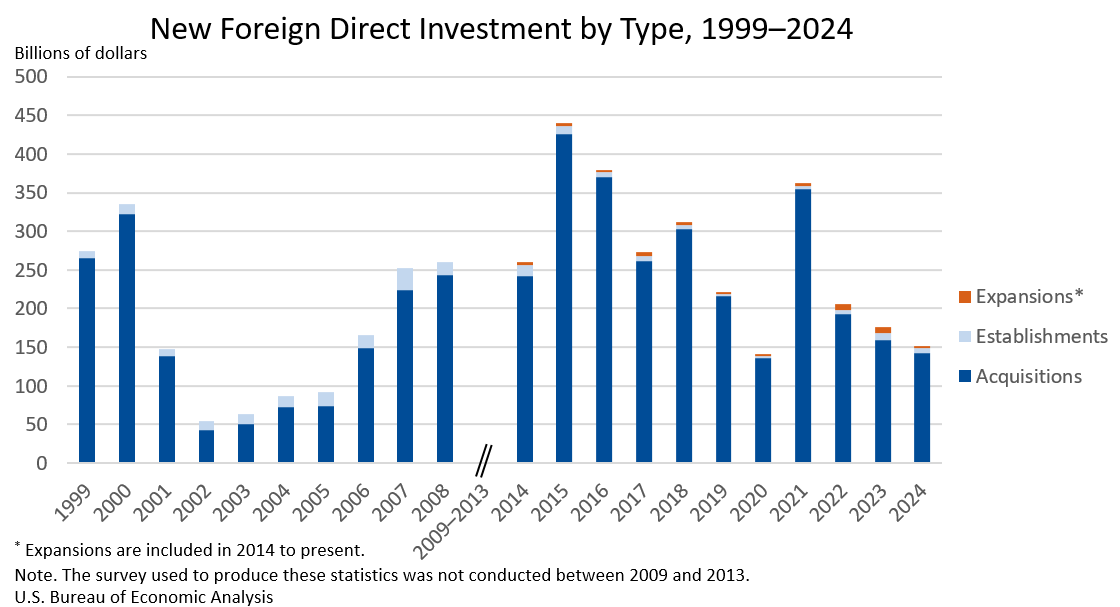Bureau of Economic Analysis
New Foreign Direct Investment in the United States, 2024
Expenditures by foreign direct investors to acquire, establish, or expand U.S. businesses totaled $151.0 billion in 2024, according to preliminary statistics released today by the U.S. Bureau of Economic Analysis. Expenditures decreased $24.9 billion, or 14.2 percent, from $176.0 billion (revised) in 2023 and were below the annual average of $277.2 billion for 2014–2023. As in previous years, acquisitions of existing U.S. businesses accounted for most of the expenditures.
Principal Federal Economic Indicators
Noteworthy
- 2025 News Release Schedule
- Innovation at BEA
- 2025 Annual Updates
- New! Services Trade Data for More Countries
- Data Tool: Trade in Value Added
- Distribution of State Personal Income
- Updated: RIMS II Regional Multipliers
- Arts and Culture
- Space Economy
- FDI Now in State BEARFACTS
- Quick Guide: Price Indexes
The Latest
Value of U.S. Liabilities Decreased More Than U.S. Assets in Second Quarter 2015
The U.S. net international investment position was -$6,688.3 billion (preliminary) at the end of the second quarter of 2015 as the value of U.S. liabilities exceeded the value of U.S. assets. At the end of the first quarter of 2015, the net investment position was -$6,801.4 billion (revised).
U.S. International Investment Position, 2nd quarter 2015
The U.S. net international investment position at the end of the second quarter of 2015 was -$6,688.3 billion (preliminary) as the value of U.S. liabilities exceeded the value of U.S. assets (chart 1, table 1). At the end of the first quarter, the net investment position was -$6,801.4 billion (revised).
Consumer Spending Rises in August
Personal income increased 0.3 percent in August, after increasing 0.5 percent in July. Wages and salaries, the largest component of personal income, rose 0.5 percent in August after rising 0.6 percent in July.
Current-dollar disposable personal income (DPI), after-tax income, increased 0.4 percent in August after increasing 0.5 percent in July.
Real DPI, income adjusted for taxes and inflation, increased 0.3…
Personal Income and Outlays, August 2015
Personal income increased $52.5 billion, or 0.3 percent, and disposable personal income (DPI) increased $47.1 billion, or 0.4 percent, in August, according to the Bureau of Economic Analysis. Personal consumption expenditures (PCE) increased $54.9 billion, or 0.4 percent.
Video Tutorials Now Available for BE-180 Survey Respondents; Webinar Coming Soon
BEA introduced two new video tutorials to assist potential filers of the BE-180 Benchmark Survey of Financial Services Transactions Between U.S. Financial Services Providers and Foreign Persons.
GDP Increases in Second Quarter
Real gross domestic product (GDP) increased 3.9 percent in the second quarter of 2015, according to the “third” estimate released by the Bureau of Economic Analysis. The growth rate was revised up 0.2 percentage point from the “second” estimate released in August. In the first quarter, real GDP increased 0.6 percent.
Gross Domestic Product, 2nd quarter 2015 (third estimate); Corporate Profits, 2nd quarter 2015 (revised estimate)
Real gross domestic product -- the value of the goods and services produced by the nation’s economy less the value of the goods and services used up in production, adjusted for price changes -- increased at an annual rate of 3.9 percent in the second quarter of 2015, according to the "third" estimate released by the Bureau of Economic Analysis. In the first quarter, real GDP increased 0.6 percent. The GDP estimate released today…
Widespread Growth in the Far West Region
Real GDP expanded in 44 of the 52 MSAs wholly contained in this region. Professional scientific, and technical services contributed the most to growth in real GDP for the region. This region accounts for 20.4 percent of the nation’s current-dollar GDP in professional, scientific, and technical services. By contrast, mining restrained growth in the region’s GDP. Grants Pass, OR and Corvallis, OR experienced the largest upturns in real GDP…
Widespread Growth Across Metropolitan Areas
Real GDP increased in 282 of the nation’s 381 metropolitan areas in 2014, led by widespread growth in professional and business services; finance, insurance, real estate, rental, and leasing; and trade.
Gross Domestic Product by Metropolitan Area, Advance 2014 and Revised 2001-2013
Real GDP increased in 282 of the nation's 381 metropolitan areas in 2014, led by growth in several industry groups: professional and business services, wholesale and retail trade, and the group of finance, insurance, real estate, rental, and leasing. Natural resources and mining remained a strong contributor to growth in several metropolitan areas. Collectively, real GDP for U. S. metropolitan areas increased 2.3 percent in 2014 after…




